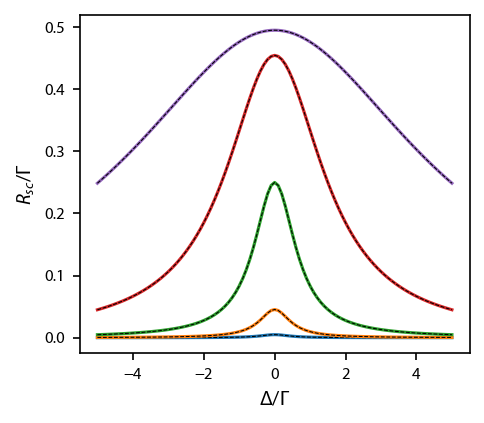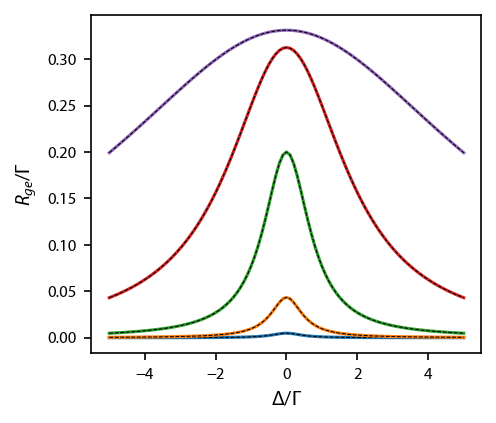Power broadening¶
Power broadening and saturation are simple effects that can replicated using the rate equations. This example shows how this works.
[1]:
import numpy as np
import matplotlib.pyplot as plt
import pylcp
Two levels with a single laser¶
This is the simplest case to consider. We will plot up the scattering rate \(R_{sc} = \sum_l R_{ge,l}(N_e-N_g)\), where \(R_{ge, l}\) is the pumping rate due to laser \(l\). We can compare to the standard analytical expression for a two-level system
which is shown in the plots as the black dashed lines.
We start by generating the Hamiltonian. Here, we use an \(F=0\rightarrow F'=1\) transition as our model system, but we will consider coupling only two of these four states together using a circularly-polarized laser beam propogating along \(\hat{z}\).
[2]:
Hg, Bgq = pylcp.hamiltonians.singleF(F=0, muB=0)
He, Beq = pylcp.hamiltonians.singleF(F=1, muB=1)
dijq = pylcp.hamiltonians.dqij_two_bare_hyperfine(0, 1)
ham = pylcp.hamiltonian(Hg, He, Bgq, Beq, dijq)
Add in a constant, small magnetic field to establish a quantization axis along the \(\hat{x}\) axis:
[3]:
magField = lambda R: np.array([1e-5, 0.0, 0.0])
We next run through a loop of both detuning and intensity, remaking the single laser every time. Note that it is \(\sigma^-\) polarized relative to both its \(k\) vector and the quantization axis.
[4]:
# Make two independent axes: dets/betas:
dets = np.arange(-5.0, 5.1, 0.1)
intensities = np.logspace(-2, 2, 5)
fig, ax = plt.subplots(nrows=1, ncols=1)
for intensity in intensities:
Rijl = np.zeros(dets.shape)
Neq = np.zeros(dets.shape + (4,))
for ii, det in enumerate(dets):
laserBeams = pylcp.laserBeams(
[{'kvec':np.array([1., 0, 0.]),
's':intensity, 'pol':-1, 'delta':det}]
)
rateeq = pylcp.rateeq(laserBeams, magField, ham)
Neq[ii] = rateeq.equilibrium_populations(
np.array([0., 0., 0.]),
np.array([0., 0., 0.]),
0.
)
Rijl[ii] = np.sum(rateeq.Rijl['g->e'], axis=2)[0][0]
ax.plot(dets, Rijl*(Neq[:, 0]-Neq[:, 1]))
ax.plot(dets, intensity/2/(1+intensity+4*dets**2), 'k--', linewidth=0.5)
ax.set_xlabel('$\Delta/\Gamma$')
ax.set_ylabel('$R_{sc}/\Gamma$');

Coupling three states together¶
Instead of just considering a single laser coupling the \(m_F=0\) and \(m_F'=-1\), we can add in a second laser and consider coupling \(m_F=0\) to \(m_F'=+1\) as well. We add this coupling laser by adding a counter propogating laser with the same circular polarization relative to its :math:`k` vector. Relative to the quanitization axis, this laser has \(\sigma^+\) light.
We then compare to the modified analytic formula
which is shown in the plot as black dashed lines.
[5]:
# Make two independent axes: dets/betas:
fig, ax = plt.subplots(nrows=1, ncols=1)
for intensity in intensities:
Rijl = np.zeros(dets.shape + (2,))
Neq = np.zeros(dets.shape + (4,))
for ii, det in enumerate(dets):
laserBeams = pylcp.laserBeams(
[{'kvec':np.array([1., 0, 0.]),
's':intensity, 'pol':-1, 'delta':det},
{'kvec':np.array([-1., 0, 0.]),
's':intensity, 'pol':-1, 'delta':det}]
)
rateeq = pylcp.rateeq(laserBeams, magField, ham)
Neq[ii] = rateeq.equilibrium_populations(
np.array([0., 0., 0.]),
np.array([0., 0., 0.]),
0.
)
Rijl[ii] = np.sum(rateeq.Rijl['g->e'], axis=2)[:, 0]
ax.plot(dets, Rijl[:, 0]*(Neq[:, 0]-Neq[:, 1]))
ax.plot(dets, intensity/2/(1+3*intensity/2+4*dets**2), 'k--', linewidth=0.5)
ax.set_xlabel('$\Delta/\Gamma$')
ax.set_ylabel('$R_{ge}/\Gamma$');

